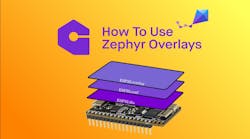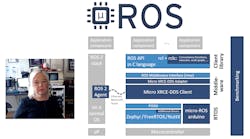What You'll Learn
- What is the Zephyr OS?
- Why is Zephyr OS important?
- Articles and videos about Zephyr OS technology.
The Zephyr OS project is a compact, multi-threaded, open-source operating system designed for IoT applications. Its small footprint and connectivity make it ideal for resource-constrained environments like wearable applications as well as commercial and industrial applications requiring security.
Zephyr offers lots of flexibility. For example, it supports multiple scheduling and queueing strategies. It uses devicetree to describe resources. And there's built-in support for networking, including Bluetooth Low Energy (BLE) 5.0.
The Zephyr OS is important as it provides a common platform for IoT applications that can work together and with the cloud. Support and functionality are similar to Linux, but in a scaled-down solution that can fit on microcontrollers. Also in the mix are code portability and middleware that developers can utilize on a range of hardware. It also has broad vendor and community support.
Check back here to see what new Zephyr content we add in the future.
Zephyr OS Versions
You can always find the latest version at the Zephyr OS website. The latest source code is downloadable from their Git repository.
Here we highlight some of the new features in various versions in these articles.
Zephyr in Action
Listed below are some examples of the Zephyr OS being used in applications or as a platform for other frameworks.
More TechXchanges on Electronic Design
These are curated collections of articles, podcasts, and videos on other technical topics.
About the Author
William G. Wong
Senior Content Director - Electronic Design and Microwaves & RF
I am Editor of Electronic Design focusing on embedded, software, and systems. As Senior Content Director, I also manage Microwaves & RF and I work with a great team of editors to provide engineers, programmers, developers and technical managers with interesting and useful articles and videos on a regular basis. Check out our free newsletters to see the latest content.
You can send press releases for new products for possible coverage on the website. I am also interested in receiving contributed articles for publishing on our website. Use our template and send to me along with a signed release form.
Check out my blog, AltEmbedded on Electronic Design, as well as his latest articles on this site that are listed below.
You can visit my social media via these links:
- AltEmbedded on Electronic Design
- Bill Wong on Facebook
- @AltEmbedded on Twitter
- Bill Wong on LinkedIn
I earned a Bachelor of Electrical Engineering at the Georgia Institute of Technology and a Masters in Computer Science from Rutgers University. I still do a bit of programming using everything from C and C++ to Rust and Ada/SPARK. I do a bit of PHP programming for Drupal websites. I have posted a few Drupal modules.
I still get a hand on software and electronic hardware. Some of this can be found on our Kit Close-Up video series. You can also see me on many of our TechXchange Talk videos. I am interested in a range of projects from robotics to artificial intelligence.





















